Paper Menu >>
Journal Menu >>
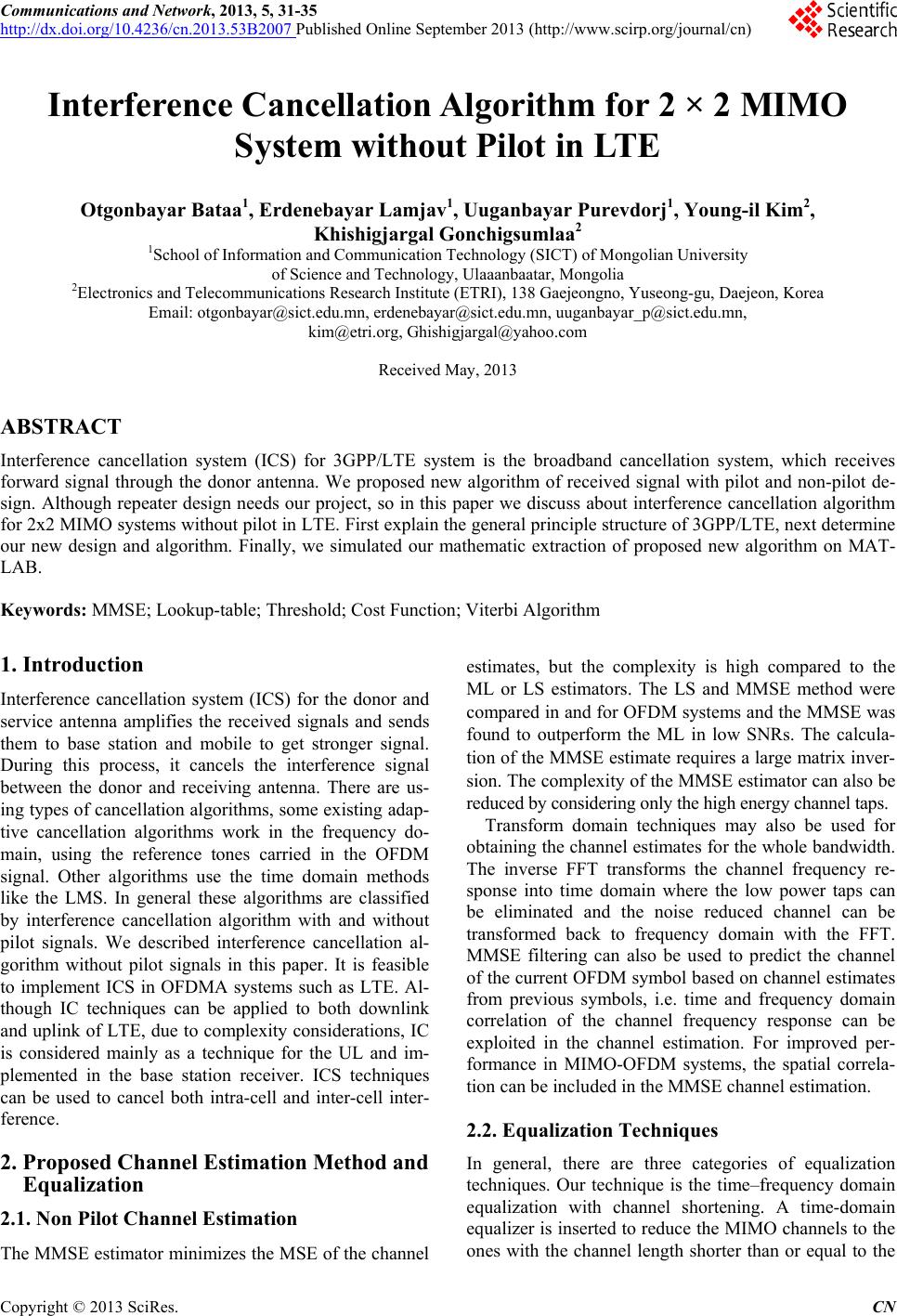 Communications and Network, 2013, 5, 31-35 http://dx.doi.org/10.4236/cn.2013.53B2007 Published Online September 2013 (http://www.scirp.org/journal/cn) Interference Cancellation Algorithm for 2 × 2 MIMO System without Pilot in LTE Otgonbayar Bataa1, Erdenebayar Lamjav1, Uuganbayar Purevdorj1, Young-il Kim2, Khishigjargal Gonchigsumlaa2 1School of Information and Communication Technology (SICT) of Mongolian University of Science and Technology, Ulaaanbaatar, Mongolia 2Electronics and Telecommunications Research Institute (ETRI), 138 Gaejeongno, Yuseong-gu, Daejeon, Korea Email: otgonbayar@sict.edu.mn, erdenebayar@sict.edu.mn, uuganbayar_p@sict.edu.mn, kim@etri.org, Ghishigjargal@yahoo.com Received May, 2013 ABSTRACT Interference cancellation system (ICS) for 3GPP/LTE system is the broadband cancellation system, which receives forward signal through the donor antenna. We proposed new algorithm of received signal with pilot and non-pilot de- sign. Although repeater design needs our project, so in this paper we discuss about interference cancellation algorithm for 2x2 MIMO systems without pilot in LTE. First explain the general principle structure of 3GPP/LTE, next determine our new design and algorithm. Finally, we simulated our mathematic extraction of proposed new algorithm on MAT- LAB. Keywords: MMSE; Lookup-table; Threshold; Cost Function; Viterbi Algorithm 1. Introduction Interference cancellation system (ICS) for the donor and service antenna amplifies the received signals and sends them to base station and mobile to get stronger signal. During this process, it cancels the interference signal between the donor and receiving antenna. There are us- ing types of cancellation algorithms, some existing adap- tive cancellation algorithms work in the frequency do- main, using the reference tones carried in the OFDM signal. Other algorithms use the time domain methods like the LMS. In general these algorithms are classified by interference cancellation algorithm with and without pilot signals. We described interference cancellation al- gorithm without pilot signals in this paper. It is feasible to implement ICS in OFDMA systems such as LTE. Al- though IC techniques can be applied to both downlink and uplink of LTE, due to complexity considerations, IC is considered mainly as a technique for the UL and im- plemented in the base station receiver. ICS techniques can be used to cancel both intra-cell and inter-cell inter- ference. 2. Proposed Channel Estimation Method and Equalization 2.1. Non Pilot Channel Estimation The MMSE estimator minimizes the MSE of the channel estimates, but the complexity is high compared to the ML or LS estimators. The LS and MMSE method were compared in and for OFDM systems and the MMSE was found to outperform the ML in low SNRs. The calcula- tion of the MMSE estimate requires a large matrix inver- sion. The complexity of the MMSE estimator can also be reduced by considering only the high energy channel taps. Transform domain techniques may also be used for obtaining the channel estimates for the whole bandwidth. The inverse FFT transforms the channel frequency re- sponse into time domain where the low power taps can be eliminated and the noise reduced channel can be transformed back to frequency domain with the FFT. MMSE filtering can also be used to predict the channel of the current OFDM symbol based on channel estimates from previous symbols, i.e. time and frequency domain correlation of the channel frequency response can be exploited in the channel estimation. For improved per- formance in MIMO-OFDM systems, the spatial correla- tion can be included in the MMSE channel estimation. 2.2. Equalization Techniques In general, there are three categories of equalization techniques. Our technique is the time–frequency domain equalization with channel shortening. A time-domain equalizer is inserted to reduce the MIMO channels to the ones with the channel length shorter than or equal to the C opyright © 2013 SciRes. CN 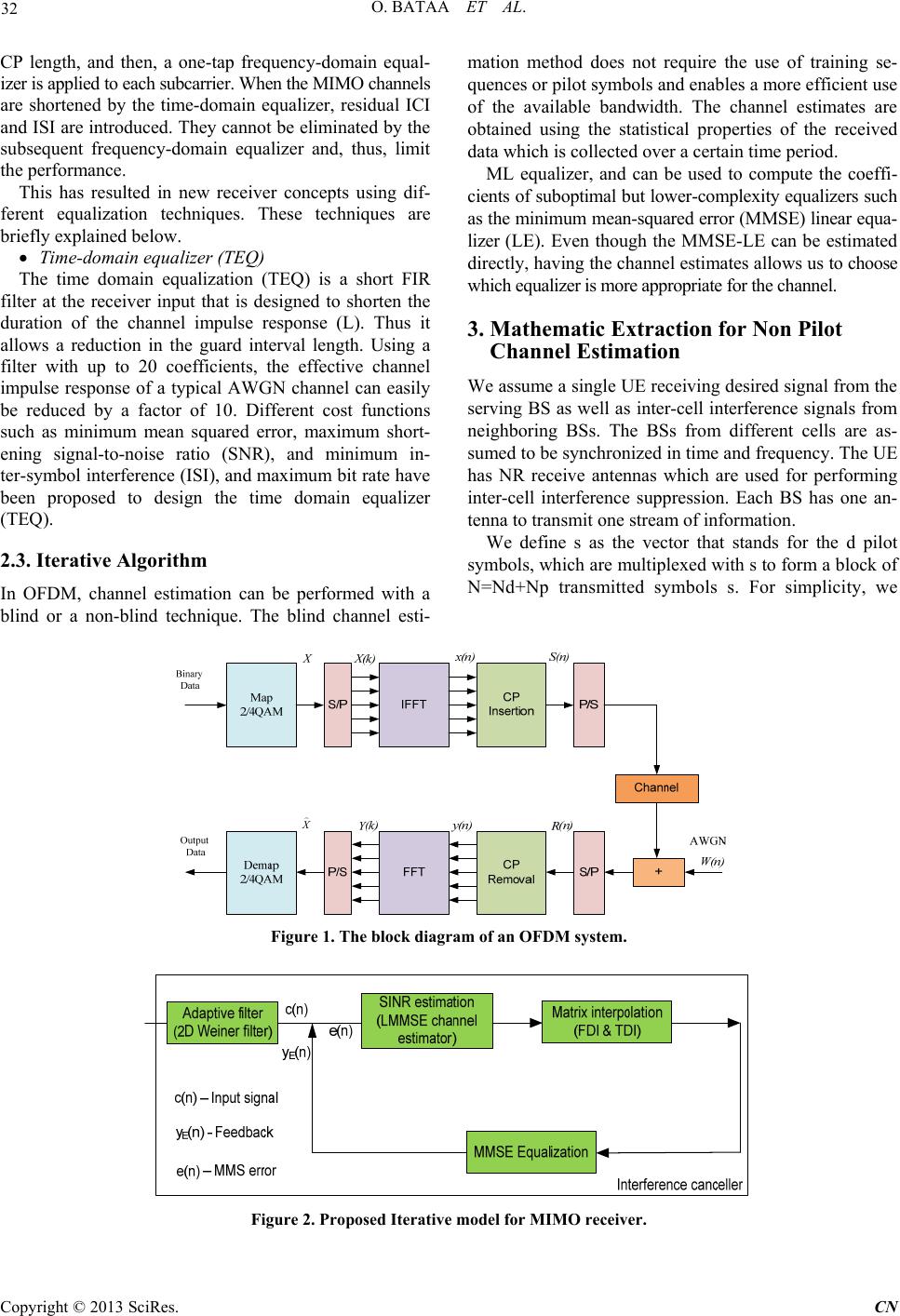 O. BATAA ET AL. 32 CP length, and then, a one-tap frequency-domain equal- izer is applied to each subcarrier. When the MIMO channels are shortened by the time-domain equalizer, residual ICI and ISI are introduced. They cannot be eliminated by the subsequent frequency-domain equalizer and, thus, limit the performance. This has resulted in new receiver concepts using dif- ferent equalization techniques. These techniques are briefly explained below. Time-domain equalizer (TEQ) The time domain equalization (TEQ) is a short FIR filter at the receiver input that is designed to shorten the duration of the channel impulse response (L). Thus it allows a reduction in the guard interval length. Using a filter with up to 20 coefficients, the effective channel impulse response of a typical AWGN channel can easily be reduced by a factor of 10. Different cost functions such as minimum mean squared error, maximum short- ening signal-to-noise ratio (SNR), and minimum in- ter-symbol interference (ISI), and maximum bit rate have been proposed to design the time domain equalizer (TEQ). 2.3. Iterative Algorithm In OFDM, channel estimation can be performed with a blind or a non-blind technique. The blind channel esti- mation method does not require the use of training se- quences or pilot symbols and enables a more efficient use of the available bandwidth. The channel estimates are obtained using the statistical properties of the received data which is collected over a certain time period. ML equalizer, and can be used to compute the coeffi- cients of suboptimal but lower-complexity equalizers such as the minimum mean-squared error (MMSE) linear equa- lizer (LE). Even though the MMSE-LE can be estimated directly, having the channel estimates allows us to choose which equalizer is more appropriate for the channel. 3. Mathematic Extraction for Non Pilot Channel Estimation We assume a single UE receiving desired signal from the serving BS as well as inter-cell interference signals from neighboring BSs. The BSs from different cells are as- sumed to be synchronized in time and frequency. The UE has NR receive antennas which are used for performing inter-cell interference suppression. Each BS has one an- tenna to transmit one stream of information. We define s as the vector that stands for the d pilot symbols, which are multiplexed with s to form a block of N=Nd+Np transmitted symbols s. For simplicity, we X Figure 1. The block diagram of an OFDM system. Figure 2. Proposed Iterative model for MIMO receiver. Copyright © 2013 SciRes. CN 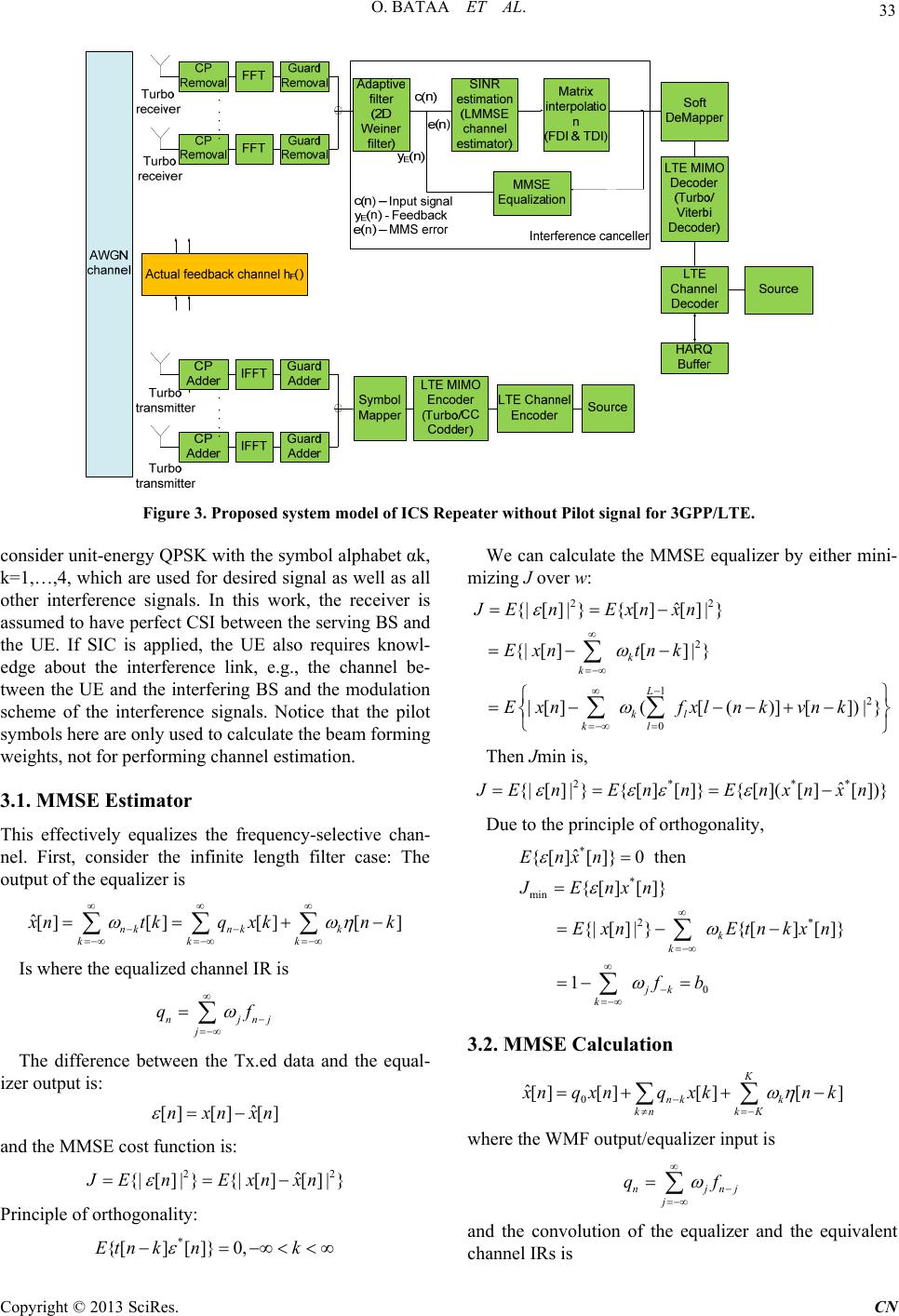 O. BATAA ET AL. 33 Figure 3. Proposed system model of ICS Repeater without Pilot signal for 3GPP/LTE. consider unit-energy QPSK with the symbol alphabet αk, k=1,…,4, which are used for desired signal as well as all other interference signals. In this work, the receiver is assumed to have perfect CSI between the serving BS and the UE. If SIC is applied, the UE also requires knowl- edge about the interference link, e.g., the channel be- tween the UE and the interfering BS and the modulation scheme of the interference signals. Notice that the pilot symbols here are only used to calculate the beam forming weights, not for performing channel estimation. 3.1. MMSE Estimator This effectively equalizes the frequency-selective chan- nel. First, consider the infinite length filter case: The output of the equalizer is ˆ[][][][ ] nk nkk kkk x ntkqxkn k nj Is where the equalized channel IR is nj j qf The difference between the Tx.ed data and the equal- izer output is: ˆ [][] []nxnxn and the MMSE cost function is: 22 ˆ {| []|}{| [][]|}JEnE xnxn Principle of orthogonality: * {[][ ]}0,Etnknk We can calculate the MMSE equalizer by either mini- mizing J over w: 22 2 12 0 ˆ {|[] |}{[][] |} {|[][]|} |[]([()][])|} k k L kl kl JE nExnxn Exn tnk Exnfxl nkvnk Then Jmin is, 2* ** ˆ {|[ ]|}{[ ][ ]}{[ ]([ ][ ])} J En EnnEnxnxn Due to the principle of orthogonality, * * min 2* 0 ˆ {[][]}0 then {[][]} {|[] |}{[][]} 1 k k jk k Enxn JEnxn Exn Etnkxn fb 3.2. MMSE Calculation 0 ˆ[][] [] [] K nk k knk K x nqxn qxknk nj where the WMF output/equalizer input is nj j qf and the convolution of the equalizer and the equivalent channel IRs is Copyright © 2013 SciRes. CN 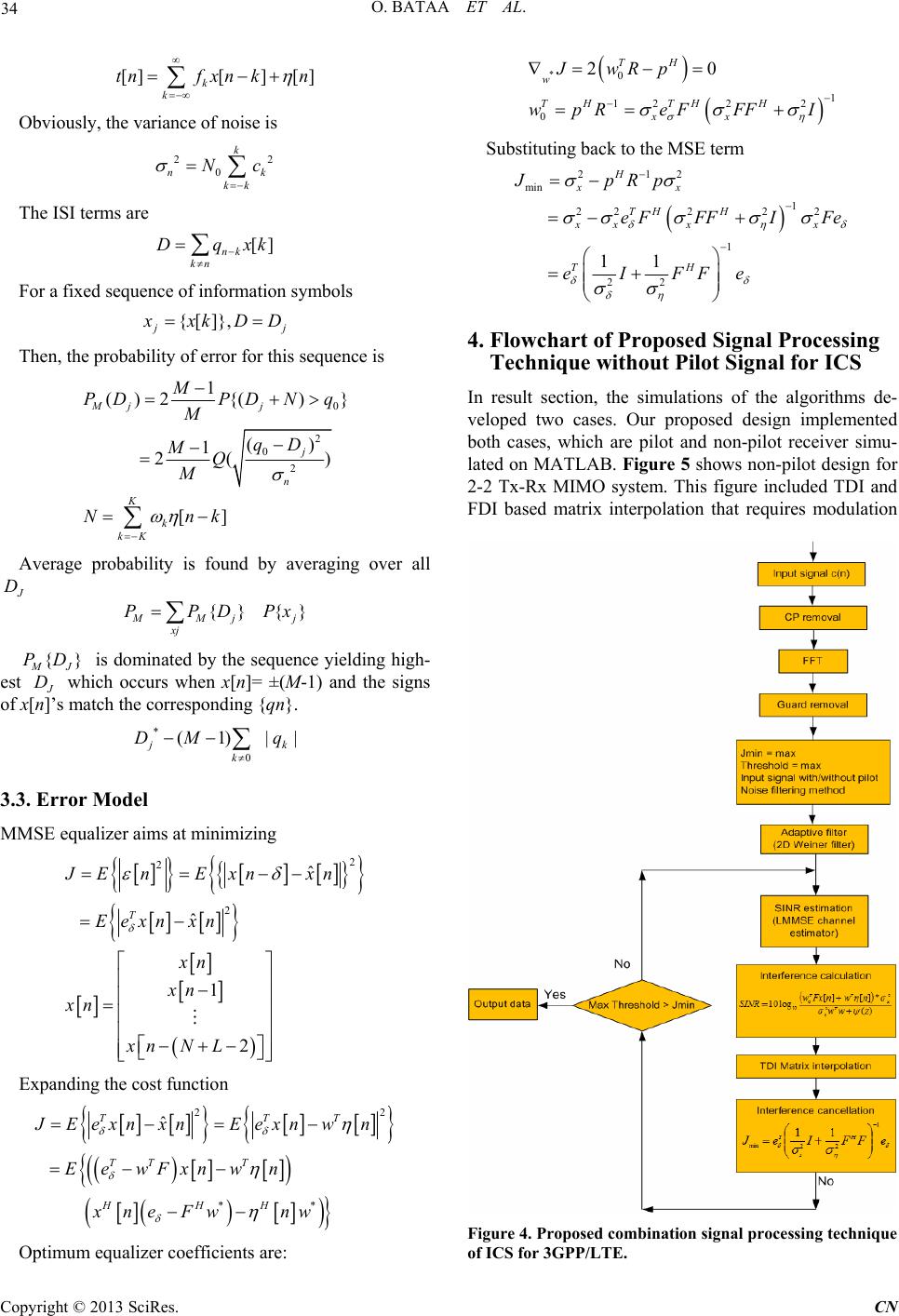 O. BATAA ET AL. 34 [][][] k k tnfxnkn Obviously, the variance of noise is 22 0 k nk kk Nc The ISI terms are [] nk kn Dqxk For a fixed sequence of information symbols {[ ]}, j j x xkD D Then, the probability of error for this sequence is 0 2 0 2 1 ()2{() } () 1 2() [] Mj j j n K k kK M PDPDNq M qD MQ M Nnk Average probability is found by averaging over all J D {} {} M Mj j xj PPDPx {} M J PD is dominated by the sequence yielding high- est J D which occurs when x[n]= ±(M-1) and the signs of x[n]’s match the corresponding {qn}. * 0 (1)|| j k k DM q 3.3. Error Model MMSE equalizer aims at minimizing 2 2 2 ˆ ˆ 1 2 T J EnE xnxn E exnxn xn xn xn xnNL Expanding the cost function 22 ** ˆ TT TT T HHH JEexnxnEexnw n EewFxnwn xne Fwnw T Optimum equalizer coefficients are: *0 1 12 22 0 20 TH w THTH H xx JwRp wpReF FFI Substituting back to the MSE term 212 min 1 2222 2 1 22 11 H xx TH H xx xx TH JpRp eF FFIFe eIFFe 4. Flowchart of Proposed Signal Processing Technique without Pilot Signal for ICS In result section, the simulations of the algorithms de- veloped two cases. Our proposed design implemented both cases, which are pilot and non-pilot receiver simu- lated on MATLAB. Figure 5 shows non-pilot design for 2-2 Tx-Rx MIMO system. This figure included TDI and FDI based matrix interpolation that requires modulation Figure 4. Proposed combination signal processing technique of ICS for 3GPP/LTE. Copyright © 2013 SciRes. CN 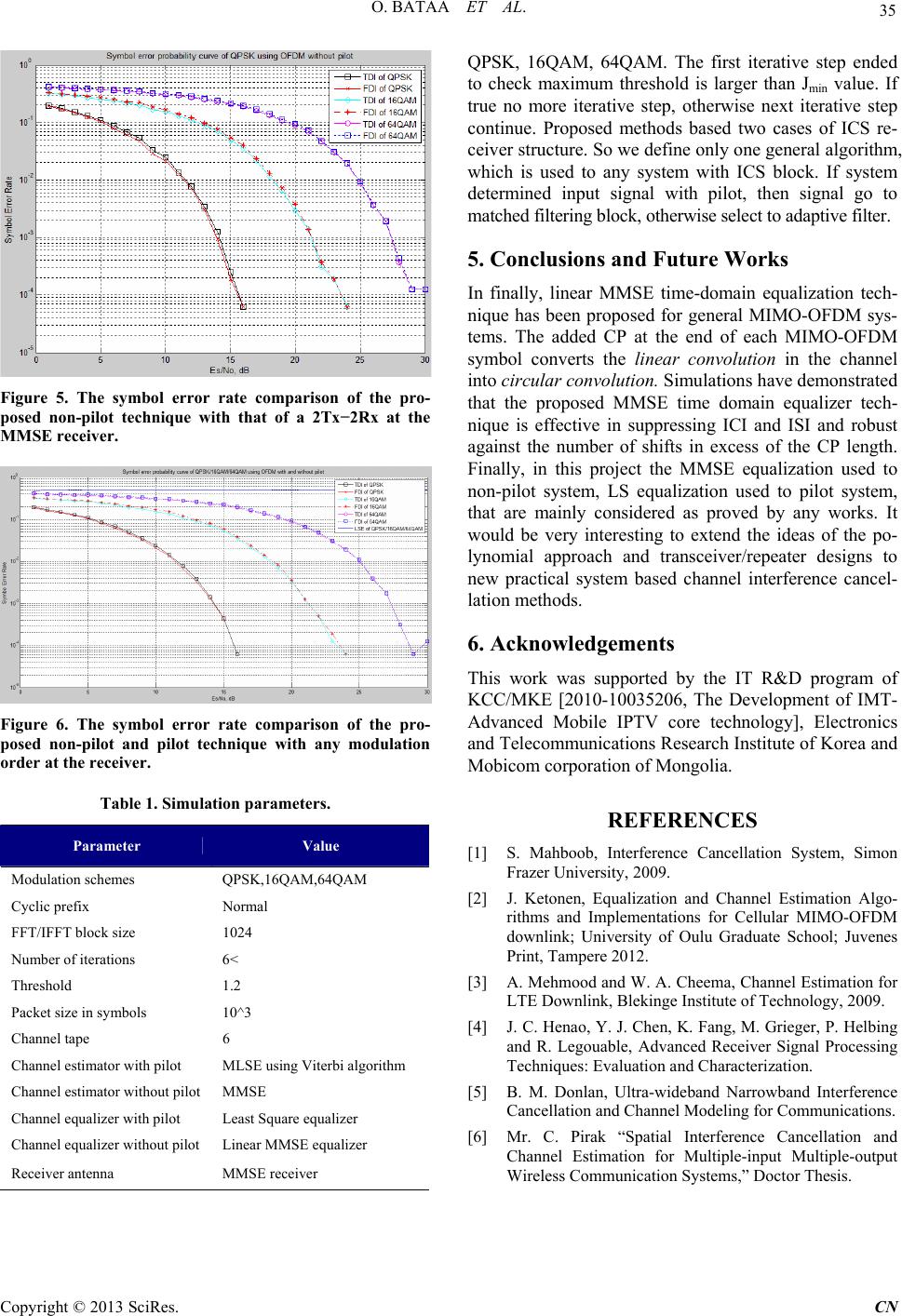 O. BATAA ET AL. Copyright © 2013 SciRes. CN 35 QPSK, 16QAM, 64QAM. The first iterative step ended to check maximum threshold is larger than Jmin value. If true no more iterative step, otherwise next iterative step continue. Proposed methods based two cases of ICS re- ceiver structure. So we define only one general algorithm, which is used to any system with ICS block. If system determined input signal with pilot, then signal go to matched filtering block, otherwise select to adaptive filter. 5. Conclusions and Future Works In finally, linear MMSE time-domain equalization tech- nique has been proposed for general MIMO-OFDM sys- tems. The added CP at the end of each MIMO-OFDM symbol converts the linear convolution in the channel into circular convolution. Simulations have demonstrated that the proposed MMSE time domain equalizer tech- nique is effective in suppressing ICI and ISI and robust against the number of shifts in excess of the CP length. Finally, in this project the MMSE equalization used to non-pilot system, LS equalization used to pilot system, that are mainly considered as proved by any works. It would be very interesting to extend the ideas of the po- lynomial approach and transceiver/repeater designs to new practical system based channel interference cancel- lation methods. Figure 5. The symbol error rate comparison of the pro- posed non-pilot technique with that of a 2Tx−2Rx at the MMSE receiver. 6. Acknowledgements This work was supported by the IT R&D program of KCC/MKE [2010-10035206, The Development of IMT- Advanced Mobile IPTV core technology], Electronics and Telecommunications Research Institute of Korea and Mobicom corporation of Mongolia. Figure 6. The symbol error rate comparison of the pro- posed non-pilot and pilot technique with any modulation order at the receiver. Table 1. Simulation parameters. REFERENCES Parameter Value Modulation schemes QPSK,16QAM,64QAM Cyclic prefix Normal FFT/IFFT block size 1024 Number of iterations 6< Threshold 1.2 Packet size in symbols 10^3 Channel tape 6 Channel estimator with pilot MLSE using Viterbi algorithm Channel estimator without pilot MMSE Channel equalizer with pilot Least Square equalizer Channel equalizer without pilot Linear MMSE equalizer Receiver antenna MMSE receiver [1] S. Mahboob, Interference Cancellation System, Simon Frazer University, 2009. [2] J. Ketonen, Equalization and Channel Estimation Algo- rithms and Implementations for Cellular MIMO-OFDM downlink; University of Oulu Graduate School; Juvenes Print, Tampere 2012. [3] A. Mehmood and W. A. Cheema, Channel Estimation for LTE Downlink, Blekinge Institute of Technology, 2009. [4] J. C. Henao, Y. J. Chen, K. Fang, M. Grieger, P. Helbing and R. Legouable, Advanced Receiver Signal Processing Techniques: Evaluation and Characterization. [5] B. M. Donlan, Ultra-wideband Narrowband Interference Cancellation and Channel Modeling for Communications. [6] Mr. C. Pirak “Spatial Interference Cancellation and Channel Estimation for Multiple-input Multiple-output Wireless Communication Systems,” Doctor Thesis. |

